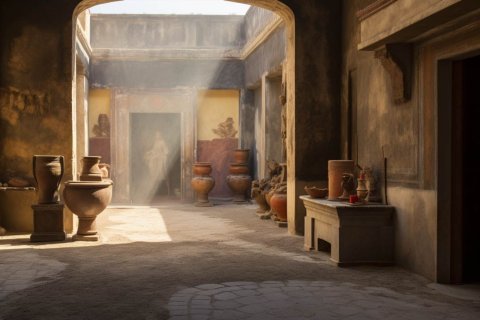Explore the Ancient Ruins of Pompeii with a Private Guided Tour from Naples
Travel back in time to the days of the Roman Empire on a fascinating 4-hour tour of Pompeii, the ancient town that was buried under molten ash by the eruption of Vesuvius in 79 AD. This private guided tour offers a unique opportunity to stroll through the remarkably intact ruins of Pompeii and discover the everyday life of its citizens.
Highlights of the Tour:
- Explore one of the world's most famous archaeological sites, Pompeii.
- Visit key attractions including the Forum, Stabian Baths, ancient brothels, and temples.
- See well-preserved structures like the House of the Faun and the old Amphitheater.
- Walk the same roads as the citizens of the Roman Republic and enter the privacy of their homes.
Upon arrival at Pompeii, enter the archaeological site and embark on a guided exploration led by an expert archaeologist guide. Marvel at the remains of thermal baths, villas, restaurants, and brothels, all frozen in time by the eruption of Vesuvius. Admire the temples, lavish villas, shops, and theaters that once thrived in this ancient Roman town.
Your Journey:
Travel comfortably from Naples to Pompeii, approximately a 30-minute drive, in a private vehicle. Spend about 2 hours at the archaeological site, choosing between an audio guided tour or a live guide in English, French, German, or Spanish. After the guided tour, enjoy some free time to explore the ruins at your own pace before the minibus transfer back to Naples.
What's Included:
- Skip-the-line entrance to Pompeii archaeological site.
- Knowledgeable archaeologist guide in Pompeii.
- Roundtrip transportation from Naples hotels with a multilingual driver.
- Complimentary bottled water during the tour.
Important Information:
What to Bring: Comfortable shoes for walking.
Not Allowed: Luggage or large bags.
Additional Details:
- This tour is for a maximum of 8 participants.
- Flexible booking: Reserve now & pay later to secure your spot.
Customer Reviews:
Rated 4.7 out of 5 based on 12 reviews. Travelers praised the intimate experience of the private tour, allowing for in-depth exploration and engaging conversations with the knowledgeable guide.
Discovering Pompeii's Secrets: Daily Life in Ancient Pompeii
Welcome to the mesmerizing world of Ancient Pompeii, where history comes alive with each step you take. Pompeii, a thriving city in ancient Italy, was tragically buried under ash and debris during the catastrophic eruption of Mount Vesuvius in 79 AD. Rediscovered centuries later, Pompeii has become a time capsule, offering invaluable insights into the daily life of its inhabitants.
Exploring the ruins of Pompeii is akin to stepping back in time. The city's well-preserved structures, vibrant frescoes, and intriguing artifacts provide a glimpse into the lives of ancient Romans. Let's delve deeper into the secrets of Pompeii's past.
Life in Ancient Pompeii
In Ancient Pompeii, life was centered around family, community, and commerce. The city boasted intricate architecture, including grand villas, public baths, temples, and theaters. Pompeiians were known for their advanced engineering and artistic prowess, as evidenced by the intricately designed buildings and artworks found within the city.
Daily Activities
The daily routine of Pompeii's residents was marked by a variety of activities. From attending performances at the theater to relaxing in the thermal baths, Pompeiians enjoyed a bustling social life. Markets filled with merchants selling exotic goods, lively taverns, and communal gathering spaces were common sights in the city.
Art and Culture
Art and culture thrived in Pompeii. Intricate mosaics adorned the floors of wealthy households, depicting scenes from mythology and daily life. Vibrant frescoes adorned the walls, showcasing Pompeiians' love for art and beauty. The city's theaters hosted plays, concerts, and other performances, reflecting the Pompeiians' appreciation for entertainment.
Religious Practices
Religion played a significant role in ancient Pompeii. The city was home to numerous temples dedicated to various gods and goddesses. Pompeiians practiced polytheism and engaged in rituals and ceremonies to seek the favor of their deities. The Temple of Apollo, the Temple of Isis, and the Forum were prominent religious sites in the city.
Rediscovering Pompeii
The rediscovery of Pompeii in the 18th century by archaeologists brought this ancient city back to life. Excavations unearthed a wealth of artifacts and structures, allowing historians and archaeologists to reconstruct the daily lives of Pompeiians with remarkable accuracy.
Visitors from around the world flock to Pompeii to witness the marvels of this ancient city. Walking through the well-preserved streets, exploring the houses, and admiring the art and architecture, one can't help but be captivated by the ingenuity of Pompeii's inhabitants.
Frequently Asked Questions
Q: What caused the destruction of Pompeii?
A: Pompeii was destroyed by the eruption of Mount Vesuvius in 79 AD. The city was buried under ash and volcanic debris, preserving it for centuries.
Q: How was Pompeii rediscovered?
A: Pompeii was rediscovered in the 18th century during excavations led by archaeologists. The city's well-preserved ruins were gradually unearthed, providing invaluable insights into ancient Roman life.
Q: What can visitors see in Pompeii today?
A: Visitors to Pompeii can explore ancient streets, houses, temples, theaters, and public baths. Well-preserved artifacts, including mosaics, frescoes, and everyday items, offer a glimpse into the daily life of Pompeii's residents.



